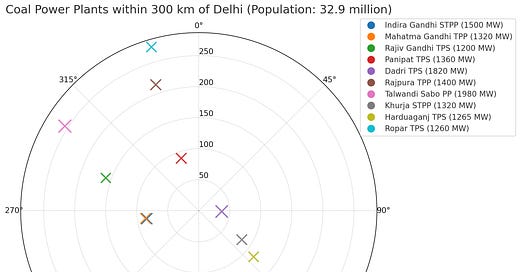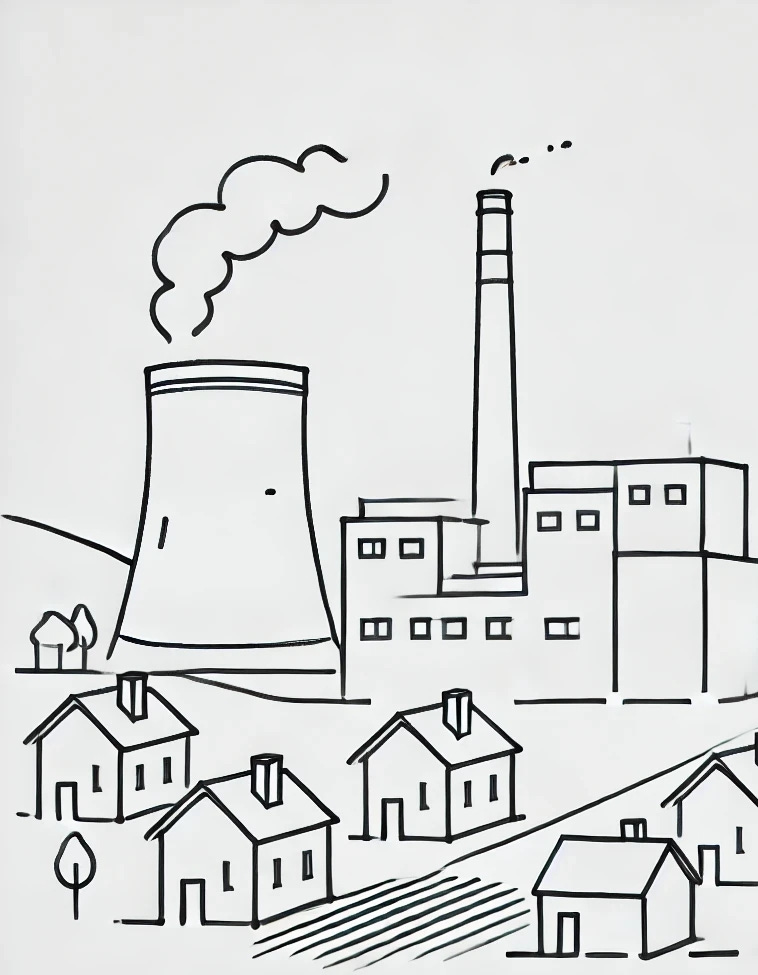Coal on your doorstep
Indian cities have coal and gas plants right next to millions of people's homes creating a catastrophic public health crisis.
I was recently in Delhi where the air quality was hazardous. An eeire smog hung in the sky and every breath was smoky and soot-laden.
Vehicular emissions and crop burning are partly to blame but there's also something else: coal combustion. But not just anywhere, it is right outside your doorstep.
Enough coal for an entire nation
There is 14 GW of coal capacity within a 300 km radius of Delhi’s centre. That is 3x Ghana’s entire electricity capacity but in only coal and around one of the most densely populated urban centres on the planet.
The amount of coal capacity is so staggeringly large that it's hard to digest. Put another way, even within a mere 100 km of Delhi’s centre, there's more coal capacity than the entire installed capacity of Nepal. Many nations have less electricity than what Delhi has in coal alone.
Figure produced by author
Not in my backyard, please
No one would place a toxic waste facility next to a school, family home or hospital but that's exactly what is happening here. People are wheezing, experiencing shortness of breath, suffering from asthma, and are getting sick more frequently. Long term effects include reduced lung capacity in kids.1 Indian cities have the worst air in the world.2
Breaking and bending the rules
What's worse is that many of these coal plants are not complying with 2015 Air Pollution Standards and are getting extensions after extensions. Flue gas desulfurization units would reduce acid rain inducing SO2 emissions but even these have not yet been installed.3
Not just a Delhi issue
Unfortunately, this problem is not confined to one urban centre. It's pervasive. Ahmedabad, a city with 7.8 million inhabitants, has a coal plant right in the city, situated in front of a cricket ground on the banks of the Sabarmati River. On the opposite bank, directly across, is a children's park.
Not just a legacy issue
More problematically, we are continuing to locate fossil fuel generation within cities. Yelahanka Raichur power station is a 370 MW gas station that is just a 30 minute drive from Bangalore’s botanical garden which is expected to begin operations in December 2024. There are temples, cafes and a spa nearby. Is it ethical to place such a facility in such close proximity to 14 million inhabitants?
Electricity can be transmitted over long distances
In the past, transmitting electrons over long distances was hard but that's no longer true today. Modern grid infrastructure is capable of transmitting power from even a 500 km distance. As a priority, we need to decommission coal that's within densely populated city centres and have proper zoning that does not allow new polluting power to appear in such close proximity.
The sunny path ahead
Moreover, cheaper and cleaner energy alternatives exist.4 Solar power is cheaper than coal and can be installed on rooftops, providing an easy in-situ solution for a good chunk of city-level energy needs.
Many Indian coal plants are anyway ageing. It’s time to ditch the old and move towards an energy system that does not deteriorate our most precious resource: the air we breathe.
https://timesofindia.indiatimes.com/city/delhi/delhi-kids-have-lower-lung-capacity-than-those-in-us/amp_articleshow/61811562.cms
https://www.iqair.com/in-en/world-most-polluted-cities?srsltid=AfmBOoqwUV0LII8NZj9TrqDKYLQSlelVw0vw_2hTYfZG9rAnm_dZBMYk
https://www.newindianexpress.com/xplore/2024/Nov/23/why-sulphur-dioxide-emission-controlled-slipped-off-priority-charts
https://www.iea.org/data-and-statistics/charts/levelised-cost-of-electricity-lcoe-for-solar-pv-and-coal-fired-power-plants-in-india-in-the-new-policies-scenario-2020-2040






I really recommend this article.* In short, the data shows declining costs for renewables but increasing costs of nuclear.
*https://ourworldindata.org/cheap-renewables-growth
I love your writing and your earnest optimism. But technical feasibility and the Indian context are two very different entities. Do you really believe Indians can build long transmission networks at all, and then prevent industrial scale pilferage of the electricity along every centimeter of cable?!